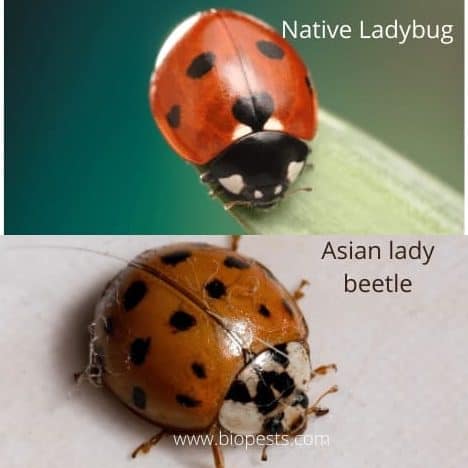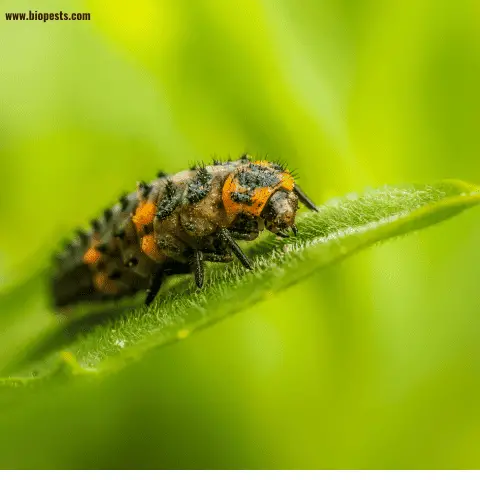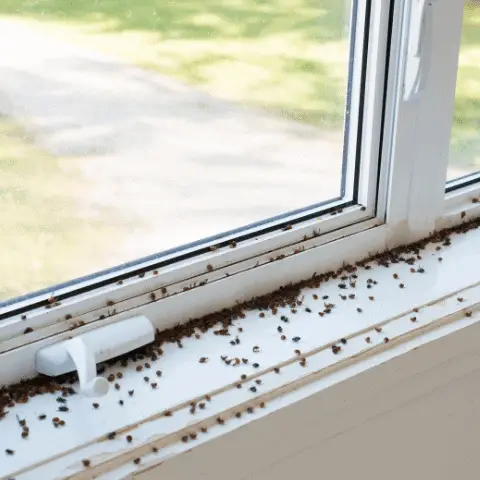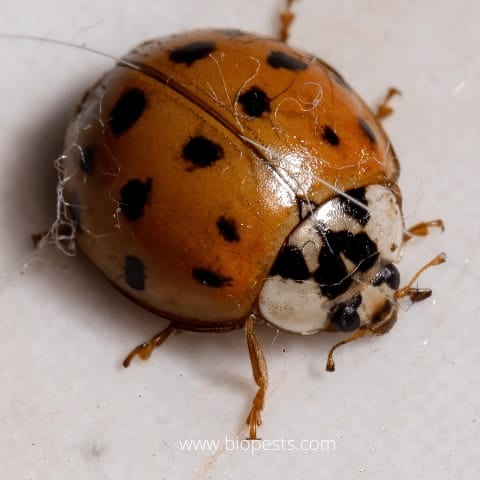It happens more and more often that we hear about insidious ladybugs. This might be quite surprising for most people, given that we have learned to love these insects early on.
How is it possible that in recent years, these harmless bugs have turned out to be not as innocent as previously thought?
The fact is that most people get confused between the Asian lady beetle and the classic ladybug, which is completely harmless.
The two belong to the same insect families and appear very similar. The resemblance pretty much ends here. The Asian lady beetle, Harmonia axyridis, is a cousin of the classic ladybug and was imported from the far east to the United States about 100 years ago to tackle the aphid problem.
As usual, when man interferes with the course of nature, things get messy, and over time it has been discovered that this kind of ladybug brings more problems than benefits. In fact, since their introduction to the United States and Canada, thousands of complaints have been reported by people who, in one way or another, have been affected by these ladybugs.
Are Asian Lady Beetles Poisonous?
While native ladybugs are not poisonous, their cousins, the Asian lady beetles, are. The greatest danger lies in the yellowish fluid they release when threatened. This is their defense mechanism which discourages predators from eating them.
This fluid, which has a pungent odor reminiscent of stink bugs, could trigger allergic reactions in very sensitive people. If you develop a rash with a ladybug bite or have problems breathing, you should immediately consult a doctor. Most allergic reactions related to Asian lady beetles are due to the protein present in their blood, which causes Angioedema. Angioedema is an allergic reaction that causes swelling and sometimes itchiness.
Asian lady beetles do not transmit parasites or diseases but can bite if disturbed or threatened. Although their bites do not cause bloody wounds and are not fatal, they can be painful. A bite from an Asian lady beetle can lead to a skin reaction that can take days.
If you need to work in the garden, in an area with many ladybugs, don’t forget to wear gloves as a precaution!
The risk for humans or pets of being bitten by a ladybug increases proportionally in the autumn and winter months because this type tends to agglomerate en masse in our homes to overwinter.
What are Asian Lady Beetles, and where did they come from?
Asian lady beetles are native to China and Japan. As I mentioned, these insects were originally imported to the United States in 1916 to control pests naturally. Its voracity makes it a fearsome hunter of aphids and other small insects that affect crops.
As was to be expected, it was impossible to contain these insects in greenhouses, and soon they reproduced and spread uncontrollably throughout the national territory. It was soon discovered that the Asian lady beetle represented fierce competition for the native ladybug species.
The American farmers unknowingly caused the extermination of the native ladybugs. Armed with the best of intentions, they imported these Asian lady beetles, unaware that they carried a dangerous fungus parasite with them called Microsporidia. Asian beetles are the natural carriers of this fungus parasite and are completely immune to it.
This fungus parasite entered America like a Trojan horse. It lives in a dormant stage within the blood of the Asian lady beetle. Unfortunately, once it infects other insects, it becomes active and deadly for the host insect. When the Microsporidia penetrates the host insect’s body, it begins to multiply until it has completely killed its host.
This means that the native ladybugs are completely defenseless in the face of the danger that the Asian lady beetle represents. Even if a native ladybug devoured the larvae or eggs of an Asian lady beetle, it would die from infection from this parasite!
What’s the difference between Asian lady beetles and native ladybugs?
Asian lady beetles differ from native ladybugs in three aspects: their appearance, their diet, and their behavior.

Appearance: The easiest way to distinguish an Asian lady beetle from a native ladybug is to look for the mark “M” or “W” (depending on which side you are looking at) behind their head. Only the Asian Lady beetle has this mark. As for their colors, they come in a variety of colors and dots.
Diet: Asian lady beetles eat aphids and various other small pests. Native ladybugs eat primarily aphids.
Behavior: Asian lady beetles seek shelter in people’s houses in the winter and can become aggressive. Native ladybugs are not aggressive and seek shelter outside.
What to do if Asian Lady Beetles invade your garden?
The Asian lady beetle is considered a beneficial insect for your garden. A single ladybug can devour thousands of aphids during its lifetime! They are a welcomed guest in our garden. They feast on small, soft-bodied insects such as aphids, whiteflies, mealybugs, and mites. Some species will not also disdain mildew, pollen, and nectar.
Ladybugs will reproduce and lay eggs in your garden near an aphid colony. It is important to identify ladybugs from their early stages when they are still larvae so as not to harm them. Their appearance is very different from what they are as adults, and they can be easily mistaken for a caterpillar or some other pest! They look like little monsters, as you can see from this picture:

A fun fact about ladybugs is that they are more efficient as predators in their larvae phase!
So, as long as the ladybug invasion is confined to the garden, it’s safe to say that it is a blessing in the biological fight against pests that affect our crops. In rare cases, Asian lady beetles could become aggressive if bothered, so it’s best to leave them alone to do their job.
A different story is when this bug invades your house “en masse” with the first cold. In that case, they are fully considered as pests.
Why do Asian Lady beetles invade your house?
With the arrival of autumn and cold weather, the Asian lady beetles will desperately look for a way to enter your home. In some areas, there have been houses stormed by ladybirds, totally covering the walls.
Some say that ladybugs are attracted to bright colors, but the reality is that they love the warmth, and that’s the reason they usually land on the sunny side of houses. They also pile up in the cracks, crevices, and openings to find a warm and dry place to spend the winter. Once they succeed in entering your house, they are a nuisance for many reasons, as I mentioned before. They bite, and worst of all, they release their stinky fluid, which stains anything it lands on and can cause allergic reactions in some people. Although they come to hibernate, meaning they won’t reproduce or lay eggs in your house, you don’t want to share your home with them during the winter.
Luckily, there are a few ways to prevent ladybugs from invading your house.
Prevent Asian lady beetles from entering your house

These are the most efficient ways to keep Asian lady beetles outside your house:
- Seal every crack, window, door, screen, or any small gaps that can make an entryway for these insects to penetrate, paying more attention to the sunny side of the house.
- Check also for pipes, cables, and wires, as these are tiny insects, and they will find their way in.
- Provide them with shelter in your garden. You could build a ladybug house that will allow them to hibernate during winter.
- Plant flowers that are known to repel these insects such as mums and lavender.
- If you chose to spray an organic insecticide on your walls, do it only outside your house, at the beginning of October. Be aware that the spray can be washed away by the rain, so repeat if necessary.
One or two ladybugs would not create any disturbance. The problem begins when they infest your house in large numbers. During the day they are hidden in their cracks or hiding places, but at night, especially towards the end of winter, they come out attracted by the light.
How to get rid of Asian Lady Beetles naturally
If you have an infestation problem and you have decided to get rid of the ladybugs, there are natural methods that do not involve the use of substances harmful to humans and animals.
First of all, don’t try to crush them! If intimidated, ladybugs give off a foul smell, not to mention the yellowish fluid that comes out of them, which will stains walls, upholstery, carpets, and clothing.
These are the most common methods used to get rid of Asian lady beetles from your house:
- Vacuum them: this is the preferred method if you don’t want to harm the ladybugs. This way they are also less likely to release their stinky fluid. You will need to empty the vacuum bag outside your house.
- Sweep with a broom. While this is possible, be aware that they can stink your floors and stain your carpets.
- Use ladybug traps. You can either purchase traps at your local garden stores or build them yourself. They are proven to be particularly efficient. If you decide to make one yourself at home, it’s super simple! Taking advantage of the fact that ladybugs are attracted to light, all you need is a bowl, fill it with water and a few drops of dish soap and place it near a light source. The reflected light will be enough to attract these insects to this deadly trap making them fall into the water.
- Apply Diatomaceous Earth: this is known also as D.E. and is made of fossilized remains of diatoms, a type of hard-shelled protists. It looks like white powder. Its tiny particles kill any insect that comes into contact with it by dehydrating them to death. It is completely safe to use in your house and won’t hurt your family nor your pets. If you want to know more about D.E. read this article.
Some of the links above are affiliate links, meaning, at no additional cost to you, I will earn a commission if you click through and make a purchase.

